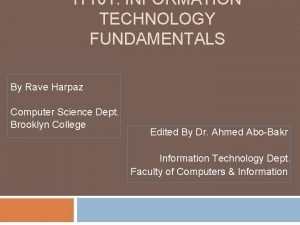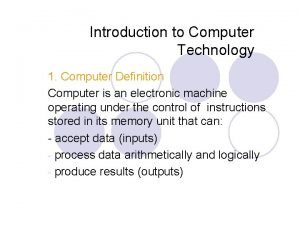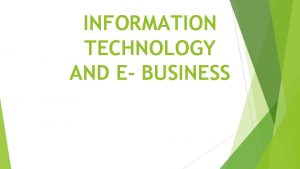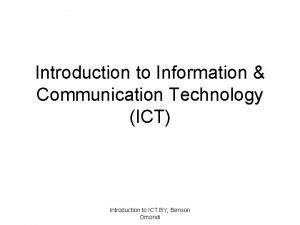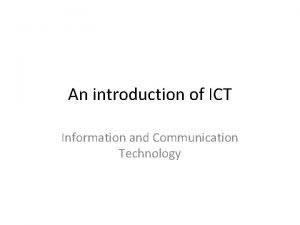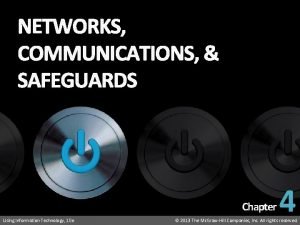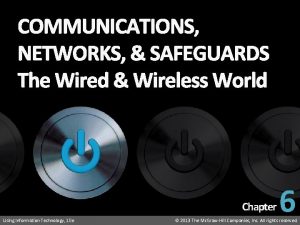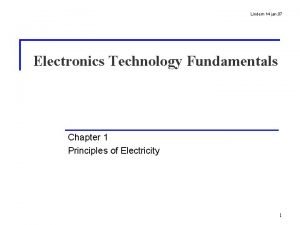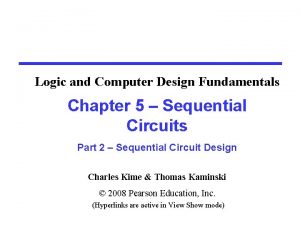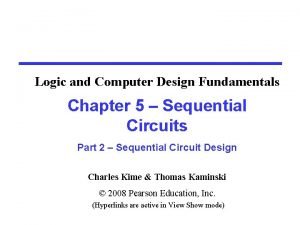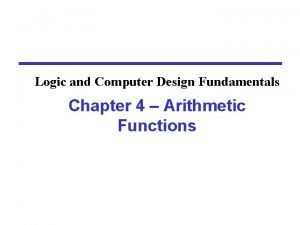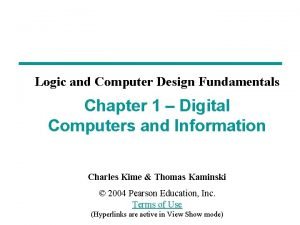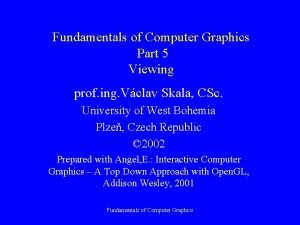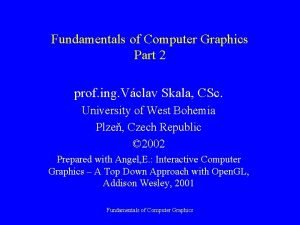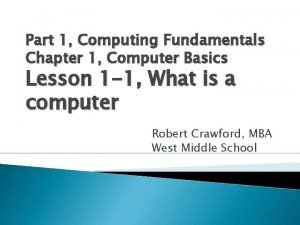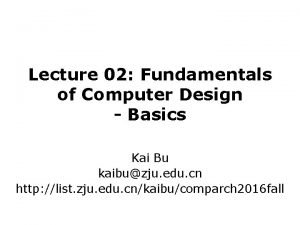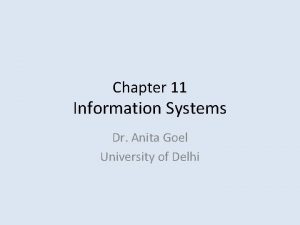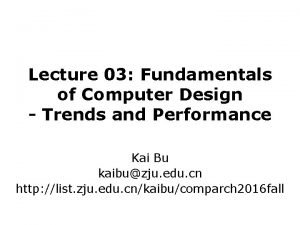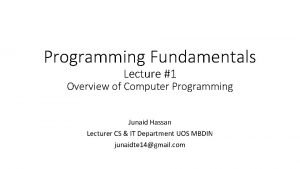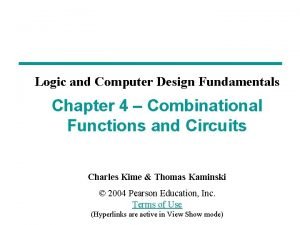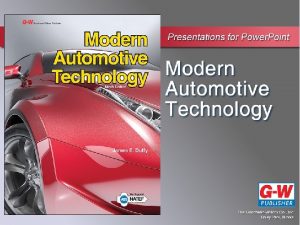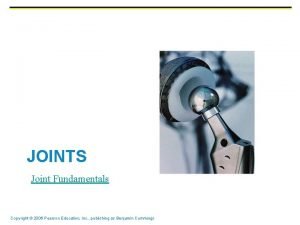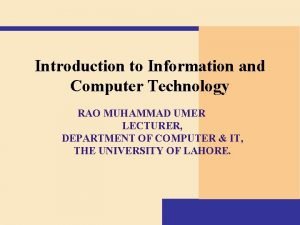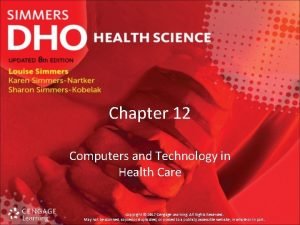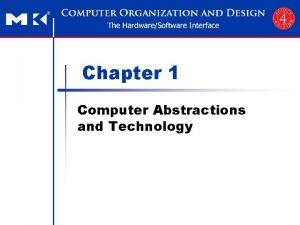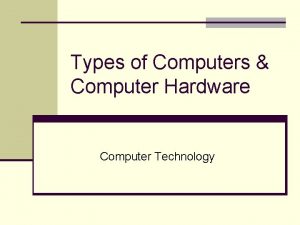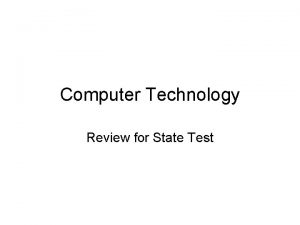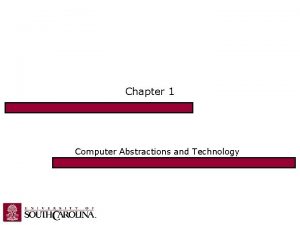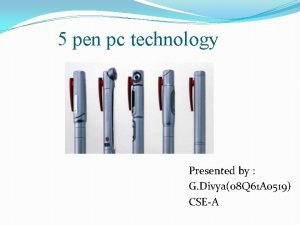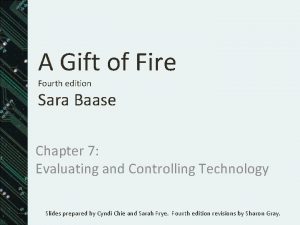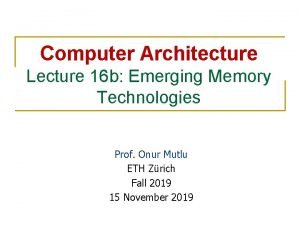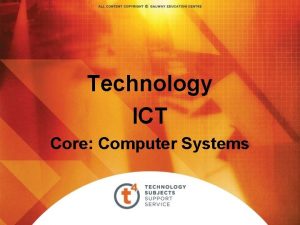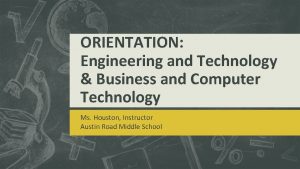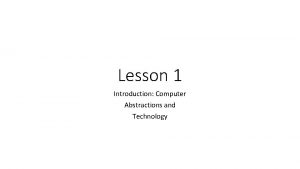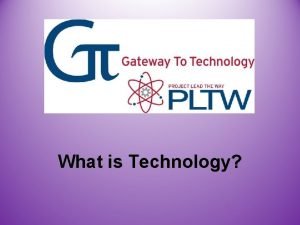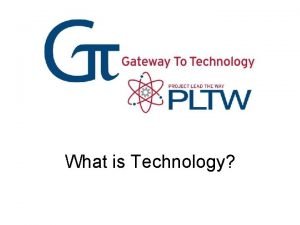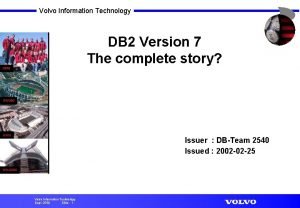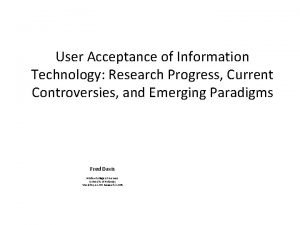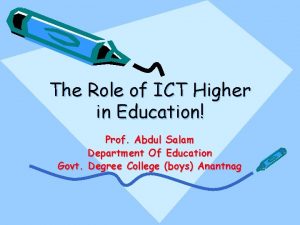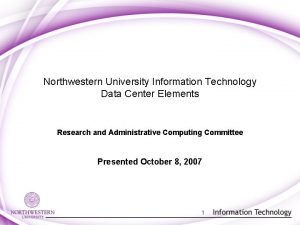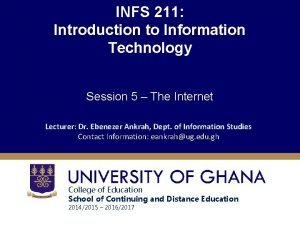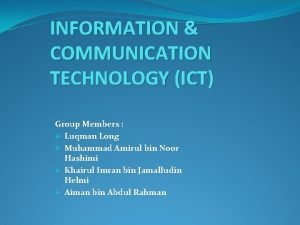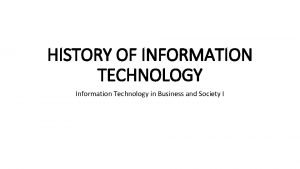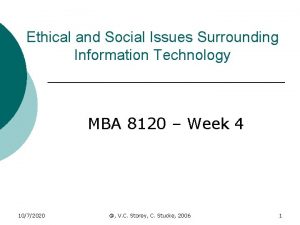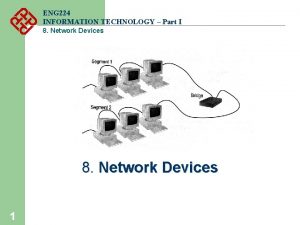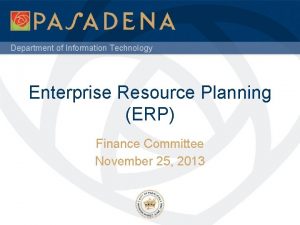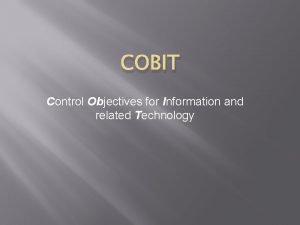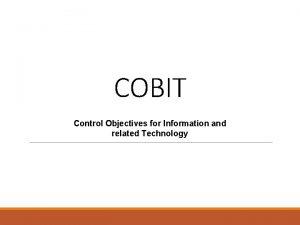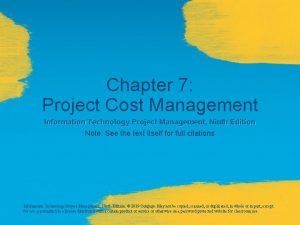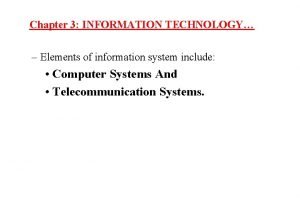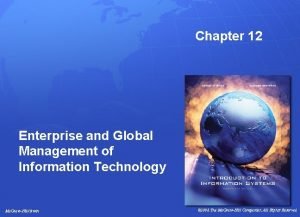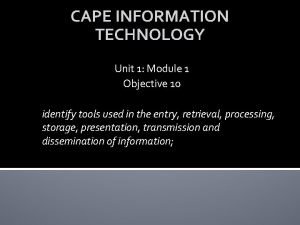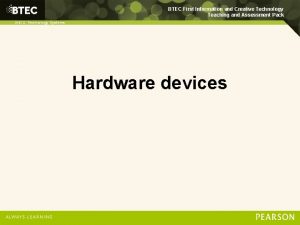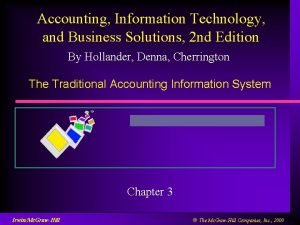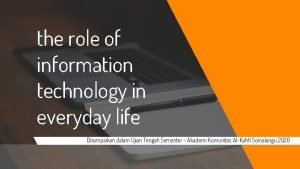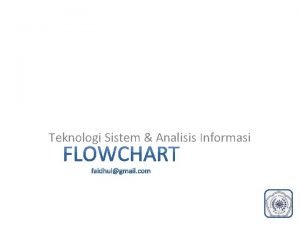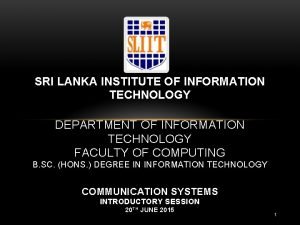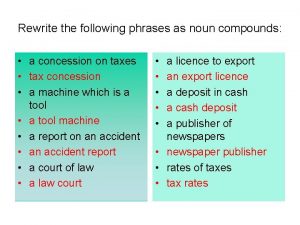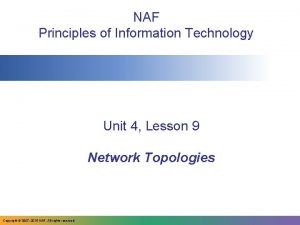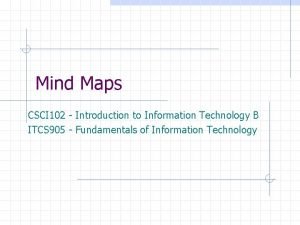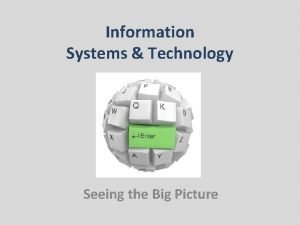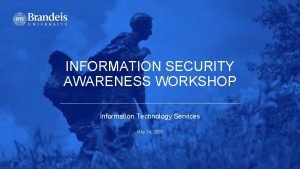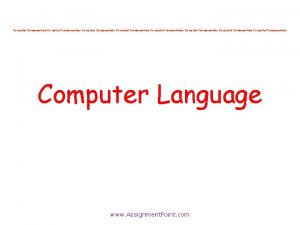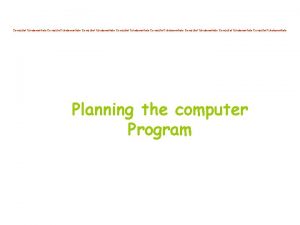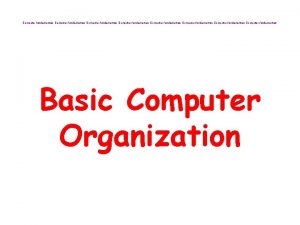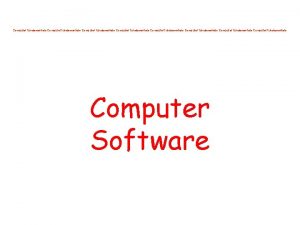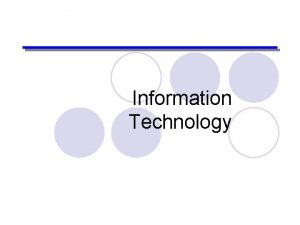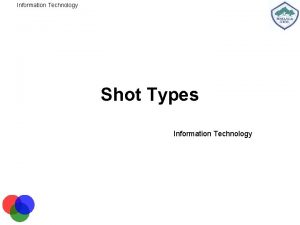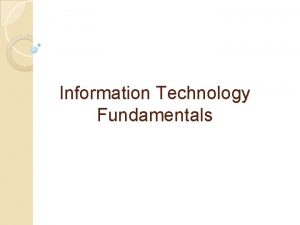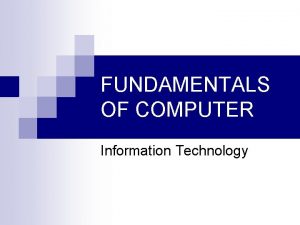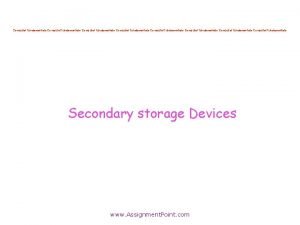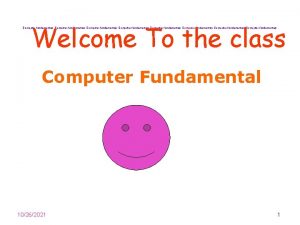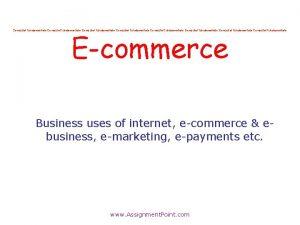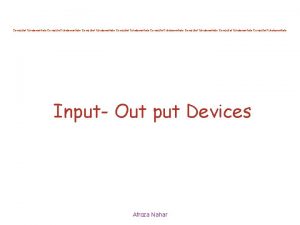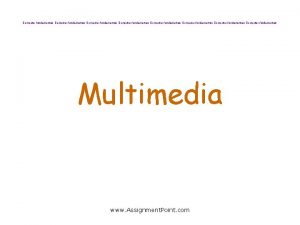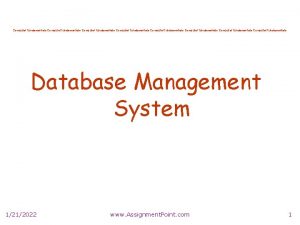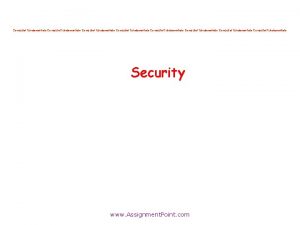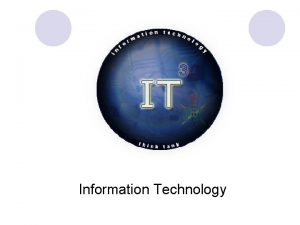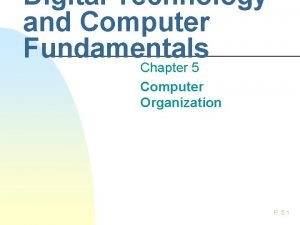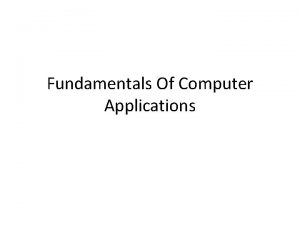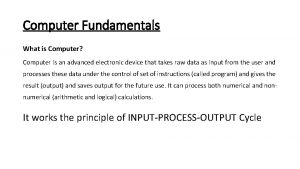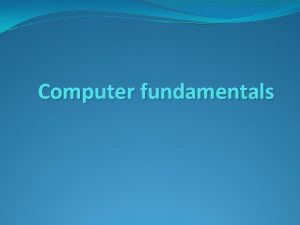FUNDAMENTALS OF INFORMATION TECHNOLOGY INTRODUCTION TO COMPUTER A

















































































- Slides: 81

FUNDAMENTALS OF INFORMATION TECHNOLOGY

INTRODUCTION TO COMPUTER ØA computer is an electronic device, operating under the control of instructions stored in its own memory that can accept data (input), process the data according to specified rules, produce information (output), and store the information for future use.

BASIC PARTS OF THE COMPUTER: Ø The basic parts of a computer are as follows − Ø Input Unit − Devices like keyboard and mouse that are used to input data and instructions to the computer are called input unit. Ø Output Unit − Devices like printer and visual display unit that are used to provide information to the user in desired format are called output unit. Ø Control Unit − As the name suggests, this unit controls all the functions of the computer. All devices or parts of computer interact through the control unit. Ø Arithmetic Logic Unit − This is the brain of the computer where all arithmetic operations and logical operations take place. Ø Memory − All input data, instructions and data interim to the processes are stored in the memory. Memory is of two types – primary memory and secondary memory. Primary memory resides within the CPU whereas secondary memory is external to it.

Characteristics of Computer ØSpeed − Typically, a computer can carry out 3 -4 million instructions per second. ØAccuracy − Computers exhibit a very high degree of accuracy. Errors that may occur are usually due to inaccurate data, wrong instructions or bug in chips – all human errors. ØReliability − Computers can carry out same type of work repeatedly without throwing up errors due to tiredness or boredom, which are very common among humans. ØVersatility − Computers can carry out a wide range of work from data entry and ticket booking to complex mathematical calculations and continuous astronomical observations. If you can input the necessary data with correct instructions, computer will do the processing. ØStorage Capacity − Computers can store a very large amount of data at a fraction of cost of traditional storage of files. Also, data is safe from normal wear and tear associated with paper.

Advantages of Using Computer ØComputers can do the same task repetitively with same accuracy. ØComputers do not get tired or bored. ØComputers can take up routine tasks while releasing human resource for more intelligent functions.

Disadvantages of Using Computer ØComputers have no intelligence; they follow the instructions blindly without considering the outcome. ØRegular electric supply is necessary to make computers work, which could prove difficult everywhere especially in developing nations.

GENERATIONS OF COMPUTER 1940 – 1956: First Generation – Vacuum Tubes • These early computers used vacuum tubes as circuitry and magnetic drums for memory. • As a result they were enormous, literally taking up entire rooms and costing a fortune to run. These were inefficient materials which generated a lot of heat, sucked huge electricity and subsequently generated a lot of heat which caused ongoing breakdowns. 1956 – 1963: Second Generation – Transistors • The replacement of vacuum tubes by transistors saw the advent of the second generation of computing. Although first invented in 1947, transistors weren’t used significantly in computers until the end of the 1950 s. They were a big improvement over the vacuum tube, despite still subjecting computers to damaging levels of heat.

Cont… 1964 – 1971: Third Generation – Integrated Circuits • By this phase, transistors were now being miniaturised and put on silicon chips (called semiconductors). This led to a massive increase in speed and efficiency of these machines. These were the first computers where users interacted using keyboards and monitors which interfaced with an operating system, a significant leap up from the punch cards and printouts. 1972 – 2010: Fourth Generation – Microprocessors • This revolution can be summed in one word: Intel. The chip-maker developed the Intel 4004 chip in 1971, which positioned all computer components (CPU, memory, input/output controls) onto a single chip. What filled a room in the 1940 s now fit in the palm of the hand. The Intel chip housed thousands of integrated circuits.

Cont… 2010 - : Fifth Generation – Artificial Intelligence ØComputer devices with artificial intelligence are still in development, but some of these technologies are beginning to emerge and be used such as voice recognition. ØAI is a reality made possible by using parallel processing and superconductors. Leaning to the future, computers will be radically transformed again by quantum computation, molecular and nano technology. ØThe essence of fifth generation will be using these technologies to ultimately create machines which can process and respond to natural language, and have capability to learn and organise themselves.

CLASSIFICATION DIGITAL COMPUTER According to functionality, Type of computers are classified as : Analog Computer • An analog computer (spelt analogue in British English) is a form of computer that uses continuous physical phenomena such as electrical, mechanical, or hydraulic quantities to model the problem being solved. Digital Computer • A computer that performs calculations and logical operations with quantities represented as digits, usually in the binary number system

Cont. . Hybrid Computer (Analog + Digital) • A combination of computers those are capable of inputting and outputting in both digital and analog signals. A hybrid computer system setup offers a cost effective method of performing complex simulations. • On the basis of Size: Type of Computer Super Computer • The fastest and most powerful type of computer Supercomputers are very expensive and are employed for specialized applications that require immense amounts of mathematical calculations. For example, weather forecasting requires a supercomputer. Other uses of supercomputers include animated graphics, fluid dynamic calculations, nuclear energy research, and petroleum exploration.

Cont… Mainframe Computer ØA very large and expensive computer capable of supporting hundreds, or even thousands, of users simultaneously. Ø In the hierarchy that starts with a simple microprocessor (in watches, for example) at the bottom and moves to supercomputers at the top, mainframes are just below supercomputers. ØIn some ways, mainframes are more powerful than supercomputers because they support more simultaneous programs. ØBut supercomputers can execute a single program faster than a mainframe.

Cont. . Mini Computer ØA midsized computer. ØIn size and power, minicomputers lie between workstations and mainframes. ØIn the past decade, the distinction between large minicomputers and small mainframes has blurred, however, as has the distinction between small minicomputers and workstations. Ø But in general, a minicomputer is a multiprocessing system capable of supporting from 4 to about 200 users simultaneously.

Cont. . Micro Computer or Personal Computer • Desktop Computer: a personal or micro-mini computer sufficient to fit on a desk. • Laptop Computer: a portable computer complete with an integrated screen and keyboard. It is generally smaller in size than a desktop computer and larger than a notebook computer. • Palmtop Computer/Digital Diary /Notebook /PDAs: a hand-sized computer. Palmtops have no keyboard but the screen serves both as an input and output device.

ANATOMY OF DIGITAL COMPUTER Central Processing Unit: It consist of three main parts ØMemory ØArithmetic and logical unit ØControl Unit

ARCHITECTURE

FUNCTIONS ØMemory: It is term, which is used in data storage, and also stored important information of data for future use and also transfer to another device when needed. We can say that it is primary type of storage or internal memory. Internal memory is executed through two types of memory technology ØRAM (Random-access-memory): It gives direct information on requirement. ØROM (Read-only-memory): By the name, it can read only not write, which means CPU can read from storage but cannot write. ØControl Unit: It defines by controlling all operation of all parts of computer. It takes information from memory and determines where is to be taken. It gives result in the output form in memory section.

Cont… Arithmetic and logical unit: Arithmetic means process like addition, subtraction, multiplication & division and all these operation is done by Arithmetic unit. Ø It solves any type of complex arithmetic operation. And in Logical part, all type of logical operations like comparing, selecting, etc. Ø It have few storage for an example registers, and which are basically made-up of electronic circuits. Ø Which having capacity to perform operations like addition, subtraction, multiplication etc.

CPU & MEMORY Central Processing Unit (CPU) consists of the following features − ØCPU is considered as the brain of the computer. ØCPU performs all types of data processing operations. ØIt stores data, intermediate results, and instructions (program). ØIt controls the operation of all parts of the computer.

CPU LOGICAL FIGURE CPU itself has following three components. ØMemory or Storage Unit ØControl Unit ØALU(Arithmetic Logic Unit)

Cont… Memory or Storage Unit: ØThis unit can store instructions, data, and intermediate results. This unit supplies information to other units of the computer when needed. It is also known as internal storage unit or the main memory or the primary storage or Random Access Memory (RAM). ØIts size affects speed, power, and capability. Primary memory and secondary memory are two types of memories in the computer. Functions of the memory unit are − ØIt stores all the data and the instructions required for processing. ØIt stores intermediate results of processing. ØIt stores the final results of processing before these results are released to an output device. ØAll inputs and outputs are transmitted through the main memory.

Cont. . Control Unit ØThis unit controls the operations of all parts of the computer but does not carry out any actual data processing operations. ØFunctions of this unit are − ØIt is responsible for controlling the transfer of data and instructions among other units of a computer. ØIt obtains the instructions from the memory, interprets them, and directs the operation of the computer. ØIt communicates with Input/Output devices for transfer of data or results from storage. ØIt does not process or store data.

Cont. . . ALU (Arithmetic Logic Unit): ØThis unit consists of two subsections namely, ØArithmetic Section ØLogic Section Arithmetic Section: ØFunction of arithmetic section is to perform arithmetic operations like addition, subtraction, multiplication, and division. All complex operations are done by making repetitive use of the above operations. Logic Section: ØFunction of logic section is to perform logic operations such as comparing, selecting, matching, and merging of data.

INPUT DEVICES Following are some of the important input devices which are used in a computer − Ø Keyboard Ø Mouse Ø Joy Stick Ø Light pen Ø Track Ball Ø Scanner Ø Graphic Tablet Ø Microphone Ø Magnetic Ink Card Reader(MICR) Ø Optical Character Reader(OCR) Ø Bar Code Reader Ø Optical Mark Reader(OMR)

Keyboard & Mouse ØKeyboard is the most common and very popular input device which helps to input data to the computer. ØThe layout of the keyboard is like that of traditional typewriter, although there are some additional keys provided for performing additional functions. Mouse: ØMouse is the most popular pointing device. ØIt is a very famous cursor-control device having a small palm size box with a round ball at its base, which senses the movement of the mouse and sends corresponding signals to the CPU when the mouse buttons are pressed.

Joystick & Light Pen ØJoystick is also a pointing device, which is used to move the cursor position on a monitor screen. ØIt is a stick having a spherical ball at its both lower and upper ends. The lower spherical ball moves in a socket. The joystick can be moved in all four directions. Light Pen: ØLight pen is a pointing device similar to a pen. Ø It is used to select a displayed menu item or draw pictures on the monitor screen. Ø It consists of a photocell and an optical system placed in a small tube.

Track Ball & Scanner Track Ball: ØTrack ball is an input device that is mostly used in notebook or laptop computer, instead of a mouse. ØThis is a ball which is half inserted and by moving fingers on the ball, the pointer can be moved. Scanner: ØScanner is an input device, which works more like a photocopy machine. ØIt is used when some information is available on paper and it is to be transferred to the hard disk of the computer for further manipulation.

Bar Code Readers & OMR Bar Code Readers ØBar Code Reader is a device used for reading bar coded data (data in the form of light and dark lines). ØBar coded data is generally used in labelling goods, numbering the books, etc. It may be a handheld scanner or may be embedded in a stationary scanner. Optical Mark Reader (OMR) ØOMR is a special type of optical scanner used to recognize the type of mark made by pen or pencil. It is used where one out of a few alternatives is to be selected and marked.

OUTPUT DEVICES Following are some of the important output devices used in a computer. • Monitors • Graphic Plotter • Printer

MONITERS ØMonitors, commonly called as Visual Display Unit (VDU), are the main output device of a computer. ØIt forms images from tiny dots, called pixels that are arranged in a rectangular form. ØThe sharpness of the image depends upon the number of pixels. There are two kinds of viewing screen used for monitors. ØCathode-Ray Tube (CRT) ØFlat-Panel Display

Cathode-Ray Tube (CRT) Monitor • The CRT display is made up of small picture elements called pixels. • The smaller the pixels, the better the image clarity or resolution. It takes more than one illuminated pixel to form a whole character, such as the letter ‘e’ in the word help. There are some disadvantages of CRT − • Large in Size • High power consumption

Flat-Panel Display Monitor • The flat-panel display refers to a class of video devices that have reduced volume, weight and power requirement in comparison to the CRT. • You can hang them on walls or wear them on your wrists. Current uses of flat-panel displays include calculators, video games, monitors, laptop computer, and graphics display. The flat-panel display is divided into two categories − • Emissive Displays − Emissive displays are devices that convert electrical energy into light. For example, plasma panel and LED (Light-Emitting Diodes). • Non-Emissive Displays − Non-emissive displays use optical effects to convert sunlight or light from some other source into graphics patterns. For example, LCD (Liquid-Crystal Device).

Printers Printer is an output device, which is used to print information on paper. There are two types of printers − • Impact Printers • Non-Impact Printers • Impact printers print the characters by striking them on the ribbon, which is then pressed on the paper. Non-impact Printers • Non-impact printers print the characters without using the ribbon. These printers print a complete page at a time, thus they are also called as Page Printers.

MEMORY • A memory is just like a human brain. • It is used to store data and instructions. Computer memory is the storage space in the computer, where data is to be processed and instructions required for processing are stored. • The memory is divided into large number of small parts called cells. Each location or cell has a unique address, which varies from zero to memory size minus one. Memory is primarily of three types − • Cache Memory • Primary Memory/Main Memory • Secondary Memory

COMPUTER SOFTWARES ØSoftware is a set of programs, which is designed to perform a well-defined function. ØA program is a sequence of instructions written to solve a particular problem. There are two types of software − • System Software • Application Software

System Software ØThe system software is a collection of programs designed to operate, control, and extend the processing capabilities of the computer itself. ØSystem software is generally prepared by the computer manufacturers. ØThese software products comprise of programs written in low-level languages, which interact with the hardware at a very basic level. ØSystem software serves as the interface between the hardware and the end users. ØSome examples of system software Operating System, Compilers, Interpreter, Assemblers, etc.

Application Software ØApplication software products are designed to satisfy a particular need of a particular environment. ØAll software applications prepared in the computer lab can come under the category of Application software. ØApplication software may consist of a single program, such as Microsoft's notepad for writing and editing a simple text. ØIt may also consist of a collection of programs, often called a software package, which work together to accomplish a task, such as a spreadsheet package.

PROGRAMMING LANGUAGE ØThe computer system is simply a machine and hence it cannot perform any work; therefore, in order to make it functional different languages are developed, which are known as programming languages or simply computer languages. Following are the major categories of Programming Languages − ØMachine Language ØAssembly Language ØHigh Level Language ØSystem Language ØScripting Language

LANGUAGES & ITS FUNCTIONS Machine Language or Code • This is the language that is written for the computer hardware. Such language is effected directly by the central processing unit (CPU) of a computer system. Assembly Language • It is a language of an encoding of machine code that makes simpler and readable. High Level Language • The high level language is simple and easy to understand it is similar to English language. For example, COBOL, FORTRAN, BASIC, C, C+, Python, etc.

OPERATING SYSTEM ØAn operating system is the fundamental basis of all other application programs. Operating system is an intermediary between the users and the hardware. ØOperating system controls and coordinates the use of hardware among application programs. The major services of an operating system are − v. Memory management v. Disk access v. Creating user interface v. Managing the different programs operating parallel v. Likewise, it controls and manage the hardware’s working

Applications of Operating System ØAn operating system is accountable for the formation and deletion of files and directories. ØAn operating system manages the process of deletion, suspension, resumption, and synchronization. ØAn operating system manages memory space by allocation and de-allocation. ØAn operating system stores, organizes, and names and protects the existing files. ØFurther, an operating system manages all the components and devices of the computers system including modems, printers, plotters, etc. ØAn operating system facilitates the interface to user and hardware.

Types of Operating System Following are the major types of operating system − • Disk Operating System (DOS) • Windows Operating System • Unix Operating System Disk Operating System: • MS-DOS is one of the oldest and widely used operating system. DOS is a set of computer programs, the major functions of which are file management, allocation of system resources, providing essential features to control hardware devices. • DOS commands can be typed in either upper case or lower case.

Windows Operating System ØThe operating system window is the extension of the disk operating system. ØIt is the most popular and simplest operating system; it can be used by any person who can read and understand basic English, as it does not require any special training. ØHowever, the Windows Operating System requires DOS to run the various application programs initially. ØBecause of this reason, DOS should be installed into the memory and then window can be executed.

Unix Operating System ØThe Unix Operating System is the earliest operating system developed in 1970 s. Let us consider the following points relating to the Unix Operating System − ØIt is an operating system that has multitasking features. ØIt has multiuser computer operating systems. ØIt runs practically on every sort of hardware and provides stimulus to the open source movement. ØIt has comparative complex functionality and hence an untrained user cannot use it; only the one who has taken training can use this system.

INTRODUCTION TO DBMS ØDatabase is a collection of related data and data is a collection of facts and figures that can be processed to produce information. ØMostly data represents recordable facts. ØData aids in producing information, which is based on facts. Ø For example, if we have data about marks obtained by all students, we can then conclude about toppers and average marks. ØA database management system stores data in such a way that it becomes easier to retrieve, manipulate, and produce information.

Applications of DBMS ØDatabase is a collection of related data and data is a collection of facts and figures that can be processed to produce information. ØMostly data represents recordable facts. Data aids in producing information, which is based on facts. For example, if we have data about marks obtained by all students, we can then conclude about toppers and average marks. ØA database management system stores data in such a way that it becomes easier to retrieve, manipulate, and produce information. Following are the important characteristics and applications of DBMS. ØACID Properties − DBMS follows the concepts of Atomicity, Consistency, Isolation, and Durability (normally shortened as ACID). These concepts are applied on transactions, which manipulate data in a database.

Cont. . Multiuser and Concurrent Access − DBMS supports multi-user environment and allows them to access and manipulate data in parallel. • Though there are restrictions on transactions when users attempt to handle the same data item, but users are always unaware of them. Multiple views − DBMS offers multiple views for different users. • A user who is in the Sales department will have a different view of database than a person working in the Production department. • This feature enables the users to have a concentrate view of the database according to their requirements.

USERS • A typical DBMS has users with different rights and permissions who use it for different purposes. • Some users retrieve data and some back it up. • The users of a DBMS can be broadly categorized as follows −

Cont. . ØAdministrators − Administrators maintain the DBMS and are responsible for administrating the database Ø They are responsible to look after its usage and by whom it should be used. ØThey create access profiles for users and apply limitations to maintain isolation and force security. ØAdministrators also look after DBMS resources like system license, required tools, and other software and hardware related maintenance. ØDesigners − Designers are the group of people who actually work on the designing part of the database. They keep a close watch on what data should be kept and in what format. They identify and design the whole set of entities, relations, constraints, and views.

WORLD WIDE WEB ØWWW stands for World Wide Web. A technical definition of the World Wide Web is : all the resources and users on the Internet that are using the Hypertext Transfer Protocol (HTTP). ØA broader definition comes from the organization that Web inventor Tim Berners- Lee helped found, the World Wide Web Consortium (W 3 C). ØThe World Wide Web is the universe of network-accessible information, an embodiment of human knowledge. ØIn simple terms, The World Wide Web is a way of exchanging information between computers on the Internet, tying them together into a vast collection of interactive multimedia resources.

Cont… • Internet and Web is not the same thing: Web uses internet to pass over the information

• World Wide Web was created by Timothy Berners Lee in 1989 at CERN in Geneva. World Wide Web came into existence as a proposal by him, to allow researchers to work together effectively and efficiently at CERN. Eventually it became World Wide Web. • The following diagram briefly defines evolution of World Wide Web:

WWW Architecture

WWW Operation ØWWW works on client- server approach. Following steps explains how the web works: ØUser enters the URL (say, http: //www. tutorialspoint. com) of the web page in the address bar of web browser. ØThen browser requests the Domain Name Server for the IP address corresponding to www. tutorialspoint. com. ØAfter receiving IP address, browser sends the request for web page to the web server using HTTP protocol which specifies the way the browser and web server communicates. ØThen web server receives request using HTTP protocol and checks its search for the requested web page. If found it returns it back to the web browser and close the HTTP connection.

FUNCTION

Cont… Future ØThere had been a rapid development in field of web. It has its impact in almost every area such as education, research, technology, commerce, marketing etc. So the future of web is almost unpredictable. ØApart from huge development in field of WWW, there also some technical issues that W 3 consortium has to cope up with. User Interface ØWork on higher quality presentation of 3 -D information is under development. The W 3 Consortium is also looking forward to enhance the web to full fill requirements of global communities which would include all regional languages and writing system.

ELECTRONIC MAILING Email is a service which allows us to send the message in electronic mode over the internet. It offers an efficient, inexpensive and real time mean of distributing information among people. E-Mail Address • Each user of email is assigned a unique name for his email account. This name is known as E-mail address. Different users can send and receive messages according to the e-mail address. • E-mail is generally of the form username@domainname. For example, webmaster@tutorialspoint. com is an e-mail address where webmaster is username and tutorialspoint. com is domain name.

E-mail Message Components

COMPONENTS FUNCTIONS E-mail Header The first five lines of an E-mail message is called E-mail header. The header part comprises of following fields: • From • Date • To • Subject • CC • BCC

OPERATIONS From • The From field indicates the sender’s address i. e. who sent the e-mail. Date • The Date field indicates the date when the e-mail was sent. To • The To field indicates the recipient’s address i. e. to whom the e-mail is sent. Subject • The Subject field indicates the purpose of e-mail. It should be precise and to the point.

CC Ø CC stands for Carbon copy. It includes those recipient addresses whom we want to keep informed but not exactly the intended recipient. BCC Ø BCC stands for Black Carbon Copy. It is used when we do not want one or more of the recipients to know that someone else was copied on the message. Greeting Ø Greeting is the opening of the actual message. Eg. Hi Sir or Hi Guys etc. Text Ø It represents the actual content of the message.

WORKING OF EMAIL Email working follows the client server approach. In this client is the mailer i. e. the mail application or mail program and server is a device that manages emails. ØSuppose person A wants to send an email message to person B. ØPerson A composes the messages using a mailer program i. e. mail client and then select Send option. ØThe message is routed to Simple Mail Transfer Protocol to person B’s mail server. ØThe mail server stores the email message on disk in an area designated for person B.

INTERNET ØInternet is defined as an Information super Highway, to access information over the web. However, It can be defined in many ways as follows: ØInternet is a world-wide global system of interconnected computer networks. ØInternet uses the standard Internet Protocol (TCP/IP). ØEvery computer in internet is identified by a unique IP address. ØIP Address is a unique set of numbers (such as 110. 22. 33. 114) which identifies a computer location. ØInternet is accessible to every user all over the world.

ARCHITECTURE

Evolution ØThe origin of Internet devised from the concept of Advanced Research Project Agency Network (ARPANET). ØARPANET was developed by United States Department of Defense. ØBasic purpose of ARPANET was to provide communication among the various bodies of government. ØInitially, there were only four nodes, formally called Hosts. ØIn 1972, the ARPANET spread over the globe with 23 nodes located at different countries and thus became known as Internet.

Advantages

Cont… • Internet allows us to communicate with the people sitting at remote locations. There are various apps available on the wed that uses Internet as a medium for communication. • • Facebook Twitter Yahoo Google+ Flickr Orkut Information regarding various topics such as Technology, Health & Science, Social Studies, Geographical Information, Information Technology, Products etc can be surfed with help of a search engine.

Disadvantages

Cont… ØThere always chances to loose personal information such as name, address, credit card number. Therefore, one should be very careful while sharing such information. One should use credit cards only through authenticated sites. ØAnother disadvantage is the Spamming corresponds to the unwanted e- mails in bulk. These e-mails serve no purpose and lead to obstruction of entire system. ØVirus can easily be spread to the computers connected to internet. Such virus attacks may cause your system to crash or your important data may get deleted. ØAlso a biggest threat on internet is pornography. There are many pornographic sites that can be found, letting your children to use internet which indirectly affects the children healthy mental life.

WEB DESIGNING ØWeb designing has direct link to visual aspect of a web site. Effective web design is necessary to communicate ideas effectively. ØWeb desinging is subset of web development. However these terms are used interchangeably. Key Points ØDesign Plan should include the following: ØDetails about information architecture. ØPlanned structure of site. ØA site map of pages

COMPTERS @ HOME, EDUCATION, HEALTH ØWith the introduction of microcomputers, personal computers became popular and people started using computers in every field whether it is banking, health, education, entertainment or business and at present time when everything is going online, it is impossible to think about anything where computers are not involved. ØComputers have become an important part of human life. ØTherefore, the importance of computers has increased in every part of human life.

@EDUCATION ØEducation is an important part of human life and it plays the most important role in shaping the life of human beings and thus shaping the future of a nation and at present computers play an important role in the way education sector works. Computers empower students with information: ØThe main purpose of education is to learn and to learn in detail about things. Computers provide access to the internet and the internet has the potential to provide information about anything and everything. ØIf a person has a computer, access to the internet, a will to learn, he can learn anything without going to school and without having a tutor.

@BUSINESS ØThe way business works have changed a lot with the introduction of computers. ØNo matter whether a business is small or large their computers are used to enhance the efficiency of a business to learn about the importance of computers in business. ØThe first importance of computers in business is managing finances. In business, several transactions take place in a day. ØBusinessman buys from various suppliers and sells products in order to make products. Ø To do this, they make the entry of products that they buy on the computer and with the help of computers assign selling prices to the goods.

@HEALTH ØComputers are frequently used in hospitals because of their speed of processing information and because of the inbuilt intelligence of computers. Ø In a large hospital, the record of patients are needed to be recorded and day to day medical works and financial works are performed using computers. ØOne of the biggest importance of computers is in the fast sharing of medical information of patients so that quick treatment can be provided. ØThe reports of medical tests can be sent to any part of the world no matter how far it is using email. doctors can read reports and can share the opinion of the doctor and the treatment of the patient can be started without delay.

@ENTERTAINMENT ØEntertainment is an integral and important part of human life. Ø We have always been looking for the means to entertain themselves and the methods of entertainment have changed and increased since the inception of computers and technology. ØMusic has always been one of the main sources of entertainment of humans and the music industry revolutionized with the introduction of computers. ØThere are so many types of software that musicians use to create music. Ø Using these software and tool the quality of music enhanced and now musicians can develop complex music which was not possible without computers.

@BANKING ØThe banking sector was one of the first sectors which were influenced by computers. Ø In the past, all the account-related information and data were kept by people on notebooks manually, which was very time consuming and error-prone. ØWith the introduction of computers, all the details related to the bank account of an individual is saved and stored in computers, which is stored in far placed servers. ØTherefore, the information is not only saved from theft but also safe from natural calamities.

INTERNET SECURITY Internet security refers to securing communication over the internet. It includes specific security protocols such as: ØInternet Security Protocol (IPSec) ØSecure Socket Layer (SSL) ØInternet Security Protocol (IPSec) ØIt consists of a set of protocols designed by Internet Engineering Task Force (IETF). It provides security at network level and helps to create authenticated and confidential packets for IP layer. ØSecure Socket Layer (SSL) ØIt is a security protocol developed by Netscape Communications Corporation. ).

Threats ØInternet security threats impact the network, data security and other internet connected systems. Cyber criminals have evolved several techniques to threat privacy and integrity of bank accounts, businesses, and organizations. v. Mobile worms Malware v. PC and Mobile ransomware v. Large scale attacks like Stuxnet that attempts to destroy infrastructure. v. Hacking as a Service v. Spam v. Phishing

VIRUS ØA computer virus is a type of malware that propagates by inserting a copy of itself into and becoming part of another program. ØIt spreads from one computer to another, leaving infections as it travels. Ø Viruses can range in severity from causing mildly annoying effects to damaging data or software and causing denial-of-service (Do. S) conditions. ØAlmost all viruses are attached to an executable file, which means the virus may exist on a system but will not be active or able to spread until a user runs or opens the malicious host file or program. ØViruses spread when the software or document they are attached to is transferred from one computer to another using the network, a disk, file sharing, or infected email attachments.

Worms ØComputer worms are similar to viruses in that they replicate functional copies of themselves and can cause the same type of damage. ØIn contrast to viruses, which require the spreading of an infected host file, worms are standalone software and do not require a host program or human help to propagate. ØTo spread, worms either exploit a vulnerability on the target system or use some kind of social engineering to trick users into executing them. Ø A worm enters a computer through a vulnerability in the system and takes advantage of file-transport or information-transport features on the system, allowing it to travel unaided. More advanced worms leverage encryption, wipers, and ransomware technologies to harm their targets.

 It 101
It 101 Computer technology introduction
Computer technology introduction Introduction to information technology
Introduction to information technology Introduction of ict
Introduction of ict Introduction to ict
Introduction to ict Introduction to information technology: your digital world
Introduction to information technology: your digital world Introduction to information technology: your digital world
Introduction to information technology: your digital world Electronics technology fundamentals
Electronics technology fundamentals Jk flip flop
Jk flip flop Fundamentals of logical computing formulation
Fundamentals of logical computing formulation 010000112
010000112 Logic and computer design fundamentals
Logic and computer design fundamentals Orthogonal projection in computer graphics
Orthogonal projection in computer graphics Sierpinski gasket in computer graphics
Sierpinski gasket in computer graphics Chapter 1 computer fundamentals
Chapter 1 computer fundamentals Fundamentals of computer design
Fundamentals of computer design Computer fundamentals anita goel
Computer fundamentals anita goel Fundamentals of computer design
Fundamentals of computer design Computer security fundamentals 4th edition
Computer security fundamentals 4th edition Programming fundamentals 1
Programming fundamentals 1 Logic & computer design fundamentals
Logic & computer design fundamentals Fundamentals of cpu in advanced computer architecture
Fundamentals of cpu in advanced computer architecture Chapter 23 computer system fundamentals
Chapter 23 computer system fundamentals Fundamentals of information systems 9th edition
Fundamentals of information systems 9th edition Fundamentals of information systems 9th edition
Fundamentals of information systems 9th edition Fundamentals of information systems chapter 1
Fundamentals of information systems chapter 1 Introduction to information systems 6th edition
Introduction to information systems 6th edition Fundamentals of information systems 9th edition
Fundamentals of information systems 9th edition Fundamentals of information systems 9th edition
Fundamentals of information systems 9th edition Pearson education, inc
Pearson education, inc Muhammad computer technology
Muhammad computer technology Definition of computer
Definition of computer Chapter 12 computer technology in health care
Chapter 12 computer technology in health care Computer abstractions and technology
Computer abstractions and technology Types of computer technology
Types of computer technology Computer technology review
Computer technology review Levels of abstraction in computer architecture
Levels of abstraction in computer architecture 5 pen technology
5 pen technology Neo luddite criticisms of computer technology
Neo luddite criticisms of computer technology Memory technology in computer architecture
Memory technology in computer architecture 3 components of computer
3 components of computer Computer technology
Computer technology Computer abstractions and technology
Computer abstractions and technology Digital differential analyzer algorithm
Digital differential analyzer algorithm Positive impacts of material technology
Positive impacts of material technology Science and technology
Science and technology Volvo information technology ab
Volvo information technology ab User acceptance of information technology
User acceptance of information technology Information and communication technology conclusion
Information and communication technology conclusion Media literacy venn diagram
Media literacy venn diagram Northwestern mailroom
Northwestern mailroom 5 disadvantages of information technology
5 disadvantages of information technology Positive impacts of ict
Positive impacts of ict History of information technology
History of information technology Fluency with information technology
Fluency with information technology Social issues in information technology
Social issues in information technology Bridge information technology
Bridge information technology Erp meaning in information technology
Erp meaning in information technology 5 trends in media and information
5 trends in media and information Control objectives for information and related technology
Control objectives for information and related technology Control objectives for information and related technology
Control objectives for information and related technology Information technology project management 9th edition
Information technology project management 9th edition Definitive estimate range
Definitive estimate range Information technology project management 9th edition ppt
Information technology project management 9th edition ppt Information technology chapter 3
Information technology chapter 3 Information technology auditing
Information technology auditing Enterprise and global management in mis
Enterprise and global management in mis Information technology resource
Information technology resource Cape information technology unit 1 notes
Cape information technology unit 1 notes Btec level 2 information and creative technology
Btec level 2 information and creative technology Accounting information technology and business solutions
Accounting information technology and business solutions Information technology in everyday life
Information technology in everyday life Gambaran flowchart dinyatakan dengan
Gambaran flowchart dinyatakan dengan Sri lanka institute of information technology colors
Sri lanka institute of information technology colors Compound noun phrases
Compound noun phrases Information technology unit 4
Information technology unit 4 Information technology mind map
Information technology mind map Arniel ping/media-and-information-literacy-communication
Arniel ping/media-and-information-literacy-communication Head of information technology
Head of information technology It assesment
It assesment Technology big picture
Technology big picture Information technology workshop
Information technology workshop
